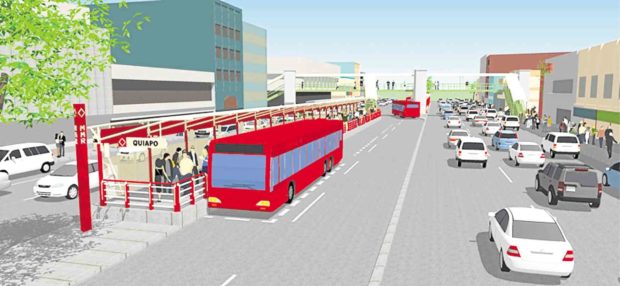With the Department of Transportation (DOTr) apparently no longer interested in setting up the proposed Bus Rapid Transit (BRT) system in Metro Manila, lawmakers have proposed that the P40-billion project be implemented by the Metropolitan Manila Development Authority (MMDA) instead.
In a hearing on Wednesday by the House committee on Metro Manila development, congressmen received an update on two BRT projects from finance and transport officials.
These are 12.3-km Line 1 from Quezon Memorial Circle to Manila City Hall via Elliptical Road, Quezon Avenue and España Boulevard worth P4.8 billion; and Line 2 or the Edsa-BRT worth P37.8 billion.
Designed to alleviate the capital’s traffic conditions, the projects were supposed to be finished by 2022.
According to a House statement on Thursday, committee members had been informed that the DOTr was withdrawing the projects. The update was relayed to the committee by Finance Undersecretary Edita Tan, who said Transportation Secretary Arthur Tugade had written the National Economic Development Agency (Neda) of his department’s decision.
Cebu project
Neda Director Hazel Iris Baliatan told committee members that the DOTr, in May 28 letter to the agency, suggested that funds just be realigned for a rail project covering the same areas. DOTr Assistant Secretary Arturo Fabillar also confirmed that the BRT projects had been withdrawn for “further studies.”
The DOTr had also recommended that the planned 23-km BRT system in Cebu City worth P10.6 billion be shelved in favor of a rail system, the committee learned.
But congressmen from Metro Manila noted that these disclosures were contrary to what the committee was told when the BRT system was being pushed and awaiting Neda’s approval.
The committee chair, Quezon City Rep. Winston Castelo, recalled that Congress approved funding for the project as it was presented by the DOTr as an immediate, cost-effective to Metro Manila’s traffic problems.
Castelo and Muntinlupa City Rep. Ruffy Biazon asked DoTr officials submit documents that supposedly served as their basis for dropping the BRT projects.
“When you went to Congress last time, you asked for these projects to be funded, you justified [them], and we were convinced,” Castelo said. “Congress acted on your response that’s why it was part of the General Appropriations Act, [but] now you’ve decided to shelve it for reasons we still don’t know.”
Marikina Rep. Bayani Fernando, a former MMDA chair, said a similar bus transit system was already in place before he left the MMDA. He expressed dismay that transportation authorities did not continue or improve on by setting up the BRT.
BF’s version
Castelo and Fernando suggested that the projects’ implementation and funding be transferred to MMDA, an idea supported by their peers.
Castelo also proposed that the version of the BRT system Fernando implemented during his time as MMDA chief be continued. He cited some its features, like the “timed” loading and unloading on the curbside.
Based on the initial plans, BRT lines are supposed to be for commuters on Quezon Avenue, Edsa and C-5. The 48.6-km Edsa BRT consists of four corridors; namely, a main corridor along Edsa, and spur corridors from Ayala Avenue to World Trade Center; Ortigas to Bonifacio Global City; and the Ninoy Aquino International Airport terminals.
